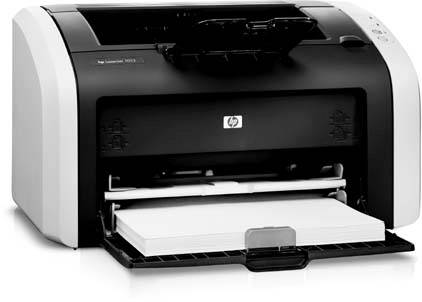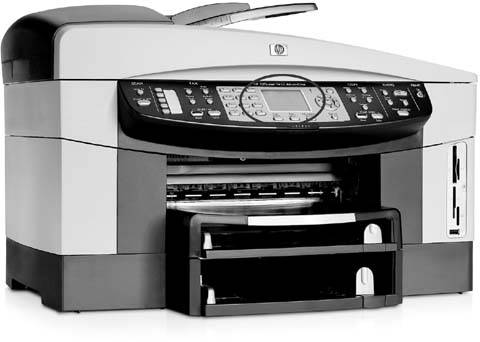Section 4.1. Printer Basics
4.1. Printer BasicsYou'll find three main kinds of printers on the market today: inkjets, laser printers, and all-in-one devices. Consumers gravitate toward inkjet and all-in-one printers; businesses lean toward laser printers. The following pages explain how these printers work, which tasks they perform best, and which one you need for your work.
4.1.1. InkjetInkjet printers (sometimes called "bubblejet" printers) bring quick and easy color printing to the masses. They're versatile as well, printing everything from perforated business cards to glossy photos to novels . Figure 4-1 shows one inkjet printer, which, like most of its brethren nowadays, is compact, quiet, and easy to use. The real deal-clincher? Inkjets are cheap$50 for a mediocre model; $200 for good one. Figure 4-1. Expensive replaceable cartridges inside inkjet printers spray ink onto paper to create photos, letters , or even iron-on T-shirt transfers. The printers come cheapusually between $50 and $200but their cartridges don't; they usually cost between $10 and $30 apiece. Inkjet printers prove cost effective for people printing casuallysay, a few times a week. But although inkjet printers sell for a song, their ink cartridges don't, much to the glee of manufacturers. Taking a tip from razor vendors , printer manufacturers sell printers at little or no profit, making up the difference by repeatedly selling you replacement ink cartridges. Inkjet printers work much like robotic airbrush artists . Tiny nozzles in the printer spray ink onto the paper, creating images in an elaborate game of point, switch colors, and spray. Surprisingly enough, the process works. Those crisp letters look haphazard only when examined under a magnifying glass. Most inkjet printers work their wonders with one black ink cartridge, and one filled with a handful of colors. Monitors can display 16.7 million colorsfar too many to fit in a shopping cart, much less a printer cartridge. So printer manufacturers took a lesson from low-budget street paintersthey fill the color cartridge with separate tubes of color: red ( magenta ), blue (cyan), and yellow. By mixing those three shades in different proportions (and sprinkling in a little black to darken the shade ), the printer mixes custom colors on the fly. Color cartridges also contain an unfortunate side effect, noticeable after printing lots of one colora Web site with lots of blue ads, for instance. When the cartridge runs out of blue, it's worthless for creating other colorseven though it may be two- thirds full of red and yellow. The manufacturer's solution? Buy a new cartridge, of course. Alternatively, some more expensive printers let you install separate cartridges for the three main colors, reducing the waste somewhat. Photo printers add three more colors to the mix: light red, light blue, or some light gray or green. The extra colors help recreate the natural colors and skin tones shown in most photographs. Tip: Always turn off your inkjet printer after using it. The printer seals the cartridges before shutting down, thereby keeping the ink from drying up. 4.1.2. LaserLaser printers (Figure 4-2) cost much more than inkjet printers, with prices starting around $150 for a low-end model. Double or triple that price for color laser printers. So why bother at all? Because when you figure in the extra costs of inkjet paper and cartridges, lasers cost much less per page to print, which can be a deal clincher for people who print on a daily basis. Laser-printed pages also stand up better to water; inkjet-printed papers smudge when pelted by rain, while your laser-printed pages escape without a blemish. Figure 4-2. Laser printers toss their dots onto a page with a complex combination of laser beams, electric charges, heat, drums, and black plastic powder known as toner. Laser printers pack 600 dots per inch, and create very clear, detailed printouts. With laser printers, it costs much less to print per page than with inkjet printers, but only the most expensive models print color. Laser printers' low per-page cost makes them attractive to people who print on a daily basis. To decide between inkjet or laser, think how often you need to print in color. Most laser printers print only blackwhich is fine for letters, but dreary for photos. The newest color laser printers boost the starting price to around $50010 times more than a low-end color inkjet, and way past most budgets . And if you want to print occasional photos, forget it. Color laser technology hasn't yet reached the level of inkjets. Laser printers take their technology from the age-old copying machine. A printer's laser projects the page's image onto a revolving drum using a dotted pattern of electric charges. The drum passes over very fine plastic powder known as toner . Just as static electricity sometimes attracts bits of dust, the powder sticks to the charged electrical pattern on the drum. The revolving drum then drops the toner onto the paper, and the printer seals it in place with pressure and heat. (That's why newly printed pages feel warm and cuddly right out of the laser printer.) The latest "laser" printers dump the laser in favor of LEDs (Light-Emitting Diodes), albeit much higher- powered LEDs than the red ones found in ugly clock radios. Instead of waving a laser at the drum, these printers send high-intensity light through a stationary row of LEDs, thus reducing mechanical breakdowns and requiring less maintenance than their old-school laser predecessors. 4.1.3. All-in-One PrintersMany well-equipped modern desks resemble an island of beached electronics with one LCD monitor protruding from the pile. All-in-one (also called multifunction ) printers (Figure 4-3) reclaim your lost elbow room by squeezing your desktop printer, scanner, and fax machine into one small unit. Combining the printer and scanner turns the unit into an on-the-fly copying machine, as well. Figure 4-3. All-in-one printers combine a desktop printer, scanner, and fax machine into one bulky but convenient package. When shopping, look for one with an ample-sized color screen (circled). You'll be working on that screen when making minor, on-the-fly edits to remove red-eye or adjust the color values in your pictures. Most all-in-one printers also offer media card readers to print photos on the fly. Remove your camera's memory card, push it into the printer's ever-so-convenient memory card slot, and select the pictures to printall without firing up your computer. Of course, that also removes your chance to crop out those strangers standing by the fountain, tweak the orange in the sunset, or airbrush out an ex. All-in-one printers sell well for several reasons:
Critics point out their flaws, as well:
4.1.4. Garage Sale ModelsOlder technology printers turn up for tempting prices at garage sales, estate sales, swap meets, and on eBay. Many still work well, and BuyPrinters (www.buyprinters.com) stocks thousands of printer ribbons and other supplies for niche models. These printers turn up most often in the bottom-feeder market:
|
- Understanding SQL Basics and Creating Database Files
- Using SQL Data Manipulation Language (DML) to Insert and Manipulate Data Within SQL Tables
- Performing Multiple-table Queries and Creating SQL Data Views
- Working with Ms-sql Server Information Schema View
- Repairing and Maintaining MS-SQL Server Database Files